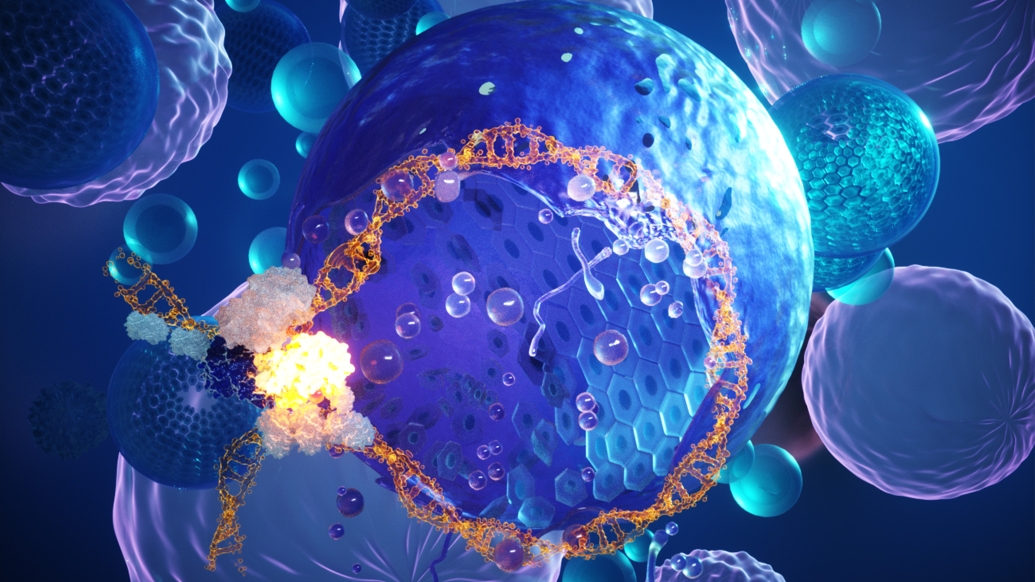Factor previously known to play a role in advanced cancer is fundamental in early stages of cancer development
8:27 AM
Author |

Researchers at the University of Michigan Health Rogel Cancer Center have uncovered a key reason why a typically normal protein goes awry and fuels cancer.
They found the protein NSD2 alters the function of the androgen receptor, an important regulator of normal prostate development.
When androgen receptor binds with NSD2, it causes rapid cell division and growth leading to prostate cancer.
The study, published in Nature Genetics, may suggest a new way to therapeutically target prostate cancer.
The findings illuminate a phenomenon not previously understood.
The androgen receptor’s normal function is to define the development of the prostate. It tells the cells to stop growing and maintain a normal prostate.
But in cancer, androgen receptor does the opposite: it tells the cells to continue growing and drive cancer development.
“Our study is one of the first molecular explanations for this functional duality of the androgen receptor,” said study first author Abhijit Parolia, Ph.D., Rogel fellow and assistant professor of pathology at Michigan Medicine.
“NSD2 is a cancer specific collaborator of the androgen receptor that essentially rewires its activity to support prostate cancer development.”
Researchers started with a CRISPR screening to look for cofactors involved in the androgen receptor and prostate cancer.
They scoured the enhanceosome, a complex of multiple proteins, including transcription factors and other epigenetic factors, that assemble on the DNA at specific sites to drive the expression of genes.
This was contrasted with what’s called the neo-enhanceosome.
It’s an analogous machinery, but cancer-causing transcription factors find their way in, reorganize the careful assembly and drive expression of cancer-causing programs.
The androgen receptor typically sits along a specific line of sites within DNA.
When NSD2 is present, it rearranges where the androgen receptor “enhanceosome” sits on the DNA, setting it next to sites occupied by known cancer-causing genes and drivers.
“This is the machinery around the genes we know are involved in prostate cancer development, including androgen receptor, ERG and FOXA1. They all use this machinery to regulate oncogenic expression. We’re now working to indirectly target the genes of interest by affecting these epigenetic components like NSD2,” said study co-senior author Arul M. Chinnaiyan, M.D., Ph.D., director of the Michigan Center for Translational Pathology and S.P. Hicks Professor of Pathology at Michigan Medicine.
Researchers found that NSD2 is expressed in prostate cancer cells, but not in normal prostate cells.
NSD2 was previously known to be involved in metastatic prostate cancer.
This is the first study to show that it is fundamental to the earliest stage of prostate cancer development.
The team used multiple methods to knockdown or halt NSD2 expression in prostate cancer cells and found that doing so returns the cells to a more normal state, slowing the growth and spread of the cancerous cells but not eliminating the cancer.
A related protein called NSD1 works along with NSD2, they found.
A compound that degrades both NSD1 and NSD2 successfully destroyed prostate cancer cell lines.
The degrader targeted the cancer cells specifically without affecting normal cells.
More work is needed to refine the degrader as the initial version could not be translated to a mouse model.
“By degrading NSD1 and NSD2, we can more directly target cancer and avoid the normal tissue,” Chinnaiyan said.
“Our study suggests if we’re able to develop NSD1/2-targeting agents, they could potentially be combined with FDA-approved androgen receptor antagonists and have a synergist effect in terms of treatment.”
Additional authors: Sanjana Eyunni, Brijesh Kumar Verma, Eleanor Young, Yihan Liu, Lianchao Liu, James George, Shweta Aras, Chandan Kanta Das, Rahul Mannan, Reyaz ur Rasool, Erick Mitchell-Velasquez, Somnath Mahapatra, Jie Luo, Sandra E. Carson, Lanbo Xiao, Prathibha R. Gajjala, Sharan Venkatesh, Mustapha Jaber, Xiaoju Wang, Tongchen He, Yuanyuan Qiao, Matthew Pang, Yuping Zhang, Jean Ching-Yi Tien, Micheala Louw, Mohammed Alhusayan, Xuhong Cao, Omid Tavana, Caiyun Hou, Zhen Wang, Ke Ding and Irfan A. Asangani.
Funding: Funding for this work is from Prostate Cancer Foundation; National Cancer Institute grants P50-CA186786, R35 CA231996, P30 CA046592, R00 CA187664, K00 CA245825, R01 CA249210-0; Department of Defense grants W81XWH-21-1-0500, W81XWH-17-0404; Howard Hughes Medical Institute, American Cancer Society. This work was supported by the Rogel Cancer Center Flow Cytometry Shared Resource.
Paper cited: “NSD2 is a requisite subunit of the AR/FOXA1 neo-enhanceosome in promoting prostate tumorigenesis,” Nature Genetics. DOI: 10.1038/s41588-024-01893-6
Sign up for Health Lab newsletters today. Get medical tips from top experts and learn about new scientific discoveries every week.
Sign up for the Health Lab Podcast. Add us wherever you listen to your favorite shows.

Explore a variety of health care news & stories by visiting the Health Lab home page for more articles.

Department of Communication at Michigan Medicine

Professor
Want top health & research news weekly? Sign up for Health Lab’s newsletters today!




